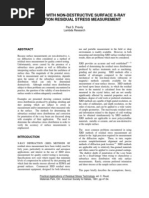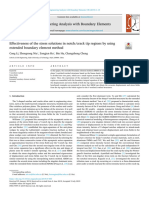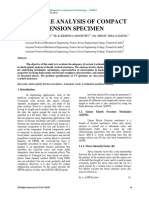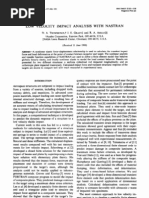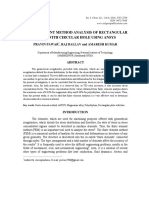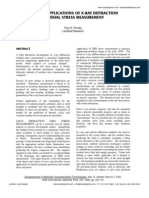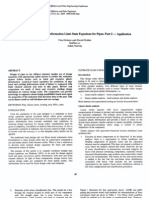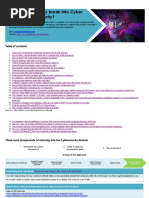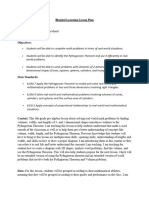152 1199 2 PB PDF
152 1199 2 PB PDF
Uploaded by
Rohit GadekarCopyright:
Available Formats
152 1199 2 PB PDF
152 1199 2 PB PDF
Uploaded by
Rohit GadekarOriginal Title
Copyright
Available Formats
Share this document
Did you find this document useful?
Is this content inappropriate?
Copyright:
Available Formats
152 1199 2 PB PDF
152 1199 2 PB PDF
Uploaded by
Rohit GadekarCopyright:
Available Formats
Stress Concentration and its Mitigation Techniques
in Flat Plate with SingularitiesA Critical Review
Shubhrata Nagpal1,*, Nitin Jain2, and Shubhashish Sanyal1
1 Mechanical
Engineering Department, NIT Raipur
Mechanics Department, NIT Raipur
*
E-mail: shubh_luck7@rediffmail.com
2 Applied
Abstract. A number of analytical, numerical and experimental techniques are
available for reduction of stress concentration factor around discontinuities.
Determination of stress concentration factor around different discontinuities in a
rectangular plate made up of different materials under different loading conditions has
been reported in literature. Mitigation of stress concentration factor although, an area
with very earlier findings however, is lesser reported in the literature. An attempt has
been made in the present work to present an overview of various techniques developed
for analysis and mitigation of stress concentration factor. The methods compared are
tabulated with their findings. No single method can be suggested for each and every
condition to the reduction of stress concentration; still the present comparative study
will help in deciding the stress mitigation method for a particular case. Singularities of
circular hole in rectangular plate and elliptical hole in rectangular plate are considered
in present study. Separate nomenclature has not been given and the terms are defined as
and where used. References are used as per their occurrence and not in a particular
order.
Keywords: Stress concentration factor, discontinuity, mitigation.
ENGINEERING JOURNAL Volume 16 Issue 1
Received 11 April 2011
Accepted 9 September 2011
Published 1 January 2012
Online at http://www.engj.org
DOI:10.4186/ej.2012.16.1.1
DOI:10.4186/ej.2012.16.1.1
1. Introduction
In recent years, researchers have put enormous amount of effort in investigating techniques for analysis
and mitigation of stress concentration. The failure of structures due to stress concentration at any
discontinuity has been baffling engineers for long. It has been found that structure failures in ships,
offshore structures, boilers or high rise buildings subjected to natural calamities is due to stress
concentration. Stress concentration mainly occurs due to discontinuities in continuum. Due to stress
concentration the magnitude of the maximum stress occurring in any discontinuity is comparatively
higher than the nominal stress. Stress concentration cause strength degradation and premature failure of
structures because of fatigue cracking and plastic deformation frequently occurring at these points.
1.1.
Stress Concentration
Stress concentration is localization of high stresses mainly due to discontinuities in continuum, abrupt
changes in cross section and due to contact stresses. To study the effect of stress concentration and
magnitude of localized stresses, a dimensionless factor called Stress Concentration Factor (SCF), Kt as
defined by Eq. (1) is used.
Kt = max / nom
(1)
where max is maximum stress at the discontinuity and nom is nominal or background stress.
A rectangular isotropic or orthotropic plate with circular hole under different types of loading have
found wide application in various fields of engineering like in automobiles, marine, aerospace and in
other engineering structures. In these plates SCF is affected by many parameters viz. plate length,
diameter of holes, dimensions of discontinuity, thickness of plate, elastic constants and many more. For
design of such plates with holes/singularities, knowledge of deflection, stresses and stress concentration
are required.
The stress concentration factor can be determined analytically by applying elasticity theory. For a
large thin plate with a small circular hole at the center, that is subjected to uni-axial far-field tension, ,
acting along the x-axis, the stresses (radial, circumferential and tangential ) around the vicinity of the
hole are given in polar coordinates r , by following equations [1], Fig. 1. :
a 2 a 2 3a 2
1 2 1 2 1 2 cos 2
2 r 2 r
r
a 2 3a 4
1 2 1 4 cos 2
2 r 2
r
rr
a 2 3a 2
r 1 2 1 2 sin 2
2
(2)
(3)
(4)
where = Angle measured counter clockwise from x-axis and a = Radius of the circular hole.
Fig. 1.
Plate with single circular hole subjected to uni-axial stress.
ENGINEERING JOURNAL Volume 16 Issue 1, ISSN 0125-8281 (http://www.engj.org)
DOI:10.4186/ej.2012.16.1.1
1.2.
Measurement of Stress
Stress analysis of the critical elements under various loading conditions is carried out by the researchers
for safe design of the element. Stress is measured by experimental methods or analytical/numerical
method.
1.2.1.
Experimental Methods
From the various experimental methods available for stress analysis, the following methods are long
established.
1.2.1.1.
Photo Elasticity
Photo elastic stress analysis is a full field technique for measuring the magnitude and direction of
principal stresses. When polarised light is passed through a stressed transparent model, interference
patterns or fringes are formed. These patterns provide immediate qualitative information about the
general distribution of stress, positions of stress concentrations and of areas of low stress using the
principals of stress optic law, Eq. (5) [2].
(5)
1 2 = N f /t
where 1 and 2 are the values of the maximum and minimum principal stresses at the point under
consideration, N is the fringe number or fringe order at the point, f is the material fringe value and t is
the model thickness.
1.2.1.2.
Brittle Coating
The brittle-lacquer technique of experimental stress analysis relies on the failure by cracking of a layer
of a brittle coating which has been applied to the surface under investigation. Specially prepared
lacquers are usually applied by spraying on the actual part. Pattern of small cracks appear on the surface
of this coating where the strain is high indicating the presence of stress concentration. The cracks also
indicate the directions of maximum strain at these points since they are always aligned at right angles to
the direction of the maximum principal tensile strain. These crack data could be used to locate strain
gauges for precise measurement of the stress. The method is however, sensitive to temperature and
humidity [2].
1.2.1.3.
Electrical Strain Gauges
The method is one of the most popular and widely accepted for strain measurements and stress analysis.
The strain gauge consists of a grid of strain-sensitive metal foil bonded to a plastic backing material.
Any change in length will result in a change of resistance. Thus measurement of this resistance change
with suitably calibrated equipment enables a direct reading of linear strain to be obtained.
Change of resistance and strain may be expressed as follows:
R / R K L / L
K R / R / L / L
R / R / K
(6)
where R and L are the changes in resistance and length respectively, K is termed as the gauge factor
and is the strain. Thus measurement of this resistance change with suitably calibrated equipment
enables a direct reading of linear strain to be obtained.
1.2.2.
Analytical/Numerical Methods
Distribution of stresses in a structure with boundary conditions, i.e. displacements and/or forces on the
boundary can be determined by using either the closed form analytical methods or by approximate
numerical methods.
ENGINEERING JOURNAL Volume 16 Issue 1, ISSN 0125-8281 (http://www.engj.org)
DOI:10.4186/ej.2012.16.1.1
Boundary value problems can be solved analytically by using constitutive equations based on the
elastic or plastic behavior of the material under load. Analytical or close-form solutions can be obtained
for simple geometries, constitutive relations and boundary conditions.
Approximate solutions for boundary-value problems can be obtained through the use of numerical
methods such as finite element method, finite difference method, boundary element method, finite
volume method and mesh less method.
1.2.2.1.
Finite Element Method
The structural model to be analysed is divided into many small pieces of simple shapes called elements.
Finite Element Analysis (FEA) program writes the equations governing the behaviour of each element
taking into consideration its connectivity to other elements through nodes. These equations relate the
unknowns, for example displacements in stress analysis, to known material properties, restraints and
loads. The program assembles the equations into a large set of simultaneous algebraic equations thousands or even millions. These equations are then solved by the program to obtain the stress
distribution for the entire model.
In recent years, with the advent of advanced softwares, the FEA based software ANSYS,
COSMOL, DIANA, ABACUS and NASTRAN have been very useful for stress analysis. These
softwares are preferred by users according to the type of stress analysis, the type of elements to be
analysed and the depth of accuracy required.
1.2.2.2.
Boundary Element Method
In this method the governing differential equation is converted into an integral form, often involving
only integrals over the boundary of the domain. Consequently, only the boundary has to be discretized
in order to carry out the integrations. The dimensionality of the problem is thereby effectively reduced
by one. A three dimensional volume problem becomes a two dimensional surface one, while a twodimensional plane problem involves only one-dimensional line integrations. Also, because the interior
of a solution domain is not discretized, there is much less approximation involved in representing the
solution variables and rapid variations of, for example, stresses and displacements can be resolved very
accurately. Stresses are accurate as there are no approximations imposed on the solution in interior
domain points. The method is suitable for modelling problems of rapidly changing stresses. Boundary
Element Method (BEM) uses less number of nodes and elements for the same level of accuracy as other
methods. The Boundary Element Method is unsuitable if information is required at a large number of
internal points [3].
1.2.2.3.
Mesh Free Method
It is an alternative numerical approach to eliminate the well-known draw backs in the finite element and
boundary element methods. Mesh free method is especially useful in the problems with discontinuous
or moving boundaries. The main objective of the Mesh Free methods is to get rid of the difficulty of
meshing and re-meshing the entire structure, by only adding or deleting nodes in the entire structure,
instead. Mesh Free methods use a set of nodes scattered within the problem domain as well as sets of
nodes scattered on the boundaries of the domain to represent the problem domain and its boundaries.
These sets of scattered nodes are called field nodes.
2. Literature Review
Analysis of stress concentration around discontinuities in plates under various loading conditions is
worked out by various researchers from as early as in 1960. Researchers have worked with different
types of discontinuities like circular hole or elliptical hole in a rectangular plate, different types of
notches like semi circular notch, V notch, U notch in a plate with different loading and material. Lately
people have also contributed significantly in the area of stress mitigation techniques. The analysis is
carried out by one of the method discussed earlier experimental or analytical. An attempt is made to
4
ENGINEERING JOURNAL Volume 16 Issue 1, ISSN 0125-8281 (http://www.engj.org)
DOI:10.4186/ej.2012.16.1.1
review few of the important contribution for analysis of stress concentration and its mitigation in the
present work.
2.1.
Analysis of Stress Concentration
The work carried out by various researchers for analysis of SCF is compiled and presented by Peterson
[4].Circular hole in an infinite plate was analyzed by Kirsch [5] and SCF value under tensile loading is
reported as 3. SCF values for finite width plate with a circular hole are determined by Howland [6] and
are presented for various a/w ratios in the form of curves. The above has been formulated by Heywood
[7] and the relation is as follows:
Ktn = 2+ (1-a/w)3
(7)
where, K tn is defined as ratio of maximum stress to nominal stress. As reported by Peterson, the above
formula is satisfactory for a/w <0.3.
Fedorov [8] studied the effect of D/A ratio and different loading on stress concentration in a glass
reinforcement plastic specimen and extended the work on anisotropy of material. He has presented
studies of 12 different models for different loads and sizes.
Stress concentration around irregular holes using complex variable methods are reported by K. R.
Y. Simha [9].Conformal mapping method has been used for evaluation of stresses. The method is an
operation in complex mathematics which maps a set of points in one coordinate system to a
corresponding set in another, keeping the angle of intersection between two curves constant, and is
widely used in solving elasticity problem. Nine hole shapes with same area and different perimeter are
studied. Irregular holes may change their shape if not their size by exchanging surface energy with
strain energy. A linear elastic analysis followed in this paper may not support the physics of change in
shapes but can be extended to a linear visco-elastic material.
Solution of plate with an elliptical hole was first given by Kolosoff [10]. Ukadgaonkar [11] has
analyzed the stresses in an infinite plate with elliptical hole or crack with tensile stresses. The closed
form solutions are given for SCF and SIF (Stress Intensity Factor). It is observed that SCF and SIF
depend on the material parameters for anisotropic material, while it is independent of material
properties in case of isotropic materials.
N. Troyani [12], showed that theoretical SCF also depends on the length of the member in addition
to the established other geometric parameters. He compared the value of SCF for short plate and long
plate for same loading and boundary conditions and introduced transition length for short members.
Transition length is defined as the length of the bar for which the calculated theoretical SCF varies 1%
0.05 % with respect to corresponding established values for long bars.
Engels [13] proposed optimal design of hole reinforcement for composite structures. Reinforcement
by elliptical doublers as well as doublers is adopted. An appropriate optimization structural model is
developed to describe the mechanical behaviour like displacement and stresses of such structures and an
appropriate mathematical optimization algorithm is used to approach the desired optimum design. The
infinite composite plate can be analyzed by the complex potential method as well as the Finite Element
Method. The implemented procedure works with good reliability, efficiency and yields optimal
reinforced designs which are useful for direct engineering applications.
Zirka et al. [14] have analyzed stress concentration around circular hole in a rectangular plate for
orthotropic and isotropic plates under dynamic and static loading. They have used photo elastic method
for analysis. The plate model is made of an anisotropic optically sensitive material with the following
properties, Elastic modulus: E1 = 4.30*103 MPa, E2 = 6.08*103 MPa; Shear modulus: G= 1.79*103 MPa;
Poissons ratios: 12 = 0.33 and 21 = 0.471 and optical constants: d1=2.5Mpa.cm / fringe,
d2=4.1Mpa .cm / fringe, and d = 4.95*10-4 cm/fringe. The dynamic photo-elastic method was used for
dynamic loading, P(t). The stress fringe patterns of the hole were recorded at a frame rate of f = 2MHz.
The curves plotted for Dynamic SCF, K - Dynamic SCF is the SCF under the dynamic loading, is
shown in Fig. 2. Dynamic SCF values are compared with the theoretical values.
The experimental values of K at some peripheral points of a hole (0 ) in orthotropic and
isotropic plates under dynamic and static loading is presented in Fig. 2. and are tabulated in Table 1.
(K)d.o., (K)d.i., (K)s.o and (K)s.i. are SCF for dynamic loading and static loading for orthotropic and
ENGINEERING JOURNAL Volume 16 Issue 1, ISSN 0125-8281 (http://www.engj.org)
DOI:10.4186/ej.2012.16.1.1
isotropic materials respectively. (K)t.o. and ( K)t.i. presents theoretical values for an orthotropic plate
(t,o) and for an isotropic plate (t,i) respectively.
Fig. 2.
Distribution of fringe order m; (a) and dynamic stress concentration factor K; (b) along
the periphery of a circular hole in an orthotropic plate [14].
Table 1. Experimental values of K at peripheral points of a hole in an orthotropic and isotropic plate
[14].
0
( K )d.o.
( K )d.i.
( K )s.o.
( K )s.i.
( K )t.o.
( K )t.i.
0
/12 /6 /4 /3 5/6
/2
3.75 3.05 1.61 0.57 0.05 -0.65 -0.92
2.72 2.12 1.16 0.32 0.04 -0.47 -0.66
3.59
1.66
0.04
-0.89
2.67 2.08 1.23 0.34 0.03 -0.46 -0.65
3.62 2.85 1.64 0.56 0.04 -0.62 -0.89
2.70 2.10 1.24 0.34 0.03 -0.45 -0.65
Zheng Yang et al. [15] Investigated the elastic stress and strain fields of finite thickness large plate
containing a hole using 3D finite element method for analysis. The maximum stress and strain are taken
as function of thickness of plate and Poissons ratio of the plate. The results are given in different curve
forms, for different geometrical element and Poissons ratio. Relation between stress concentration
factor and strain concentration factor - strain concentration factor is the ratio of strains in direction of
loading to net strain in the element at discontinuity, has also been studied.
Mittal and Jain [16] proposed finite element analysis for determination of Stress Concentration and
deflection in isotropic, orthotropic and laminated composite plates with central circular hole under
transverse static loading. Plate with uniformly distributed loading and with loading at boundary of hole
was considered for analysis, as shown in Fig. 3. The effect of D/A ratio upon SCF for normal stress in
X and Y directions is reported. Variation in SCF for different boundary conditions at the edges of plate
has been analyzed.
ENGINEERING JOURNAL Volume 16 Issue 1, ISSN 0125-8281 (http://www.engj.org)
DOI:10.4186/ej.2012.16.1.1
Fig. 3.
Plate with circular hole under different loading conditions: (a) A laminated plate with central
hole; (b) Uniformly distributed loading of P Newton; (c) Loading at boundary of hole. [16]
The equations have been developed by Roark to fit as closely as possible the many data points
given in the literature by many researchers through experiments and analytical methods. Roark
developed the following equation for SCF based on the work of Flynn and Heywood [7]:
Kt=3.0 - 3.13(2r/D) + 3.66(2r/D)2 -1.53(2r/D)3
(8)
where 2r = Diameter of hole and D = Width of plate .
T. Hasan [17] has reported stress analysis of steel plate having holes of various shapes, sizes and
orientations using finite element method. Finite element analysis is carried out by using the commercial
software COMSOL 3.3. The rectangular plate with elliptical hole subjected to uni-axial load used for
analysis is shown in Fig.4.
Fig. 4.
Rectangular plate with elliptical hole subjected to uni-axial load [17].
Results are presented in the form of graphs as shown in Fig. 5(a). Effects of hole shape are critically
analyzed from the results of the finite element method and analytical methods. Comparisons between
the results by the present finite element method and the analytical solution technique yields good
agreement.
For elliptical hole, with the increase of plate length to width ratio the maximum stress at all angular
position increases as shown in Fig. 5(a). At 0 angular position of elliptical hole, maximum stress
occurs at the two ends of hole on its minor axis. At 90 angular position of elliptical hole, maximum
stress occurs at the two ends of hole on its major axis Fig. 5(b).
ENGINEERING JOURNAL Volume 16 Issue 1, ISSN 0125-8281 (http://www.engj.org)
DOI:10.4186/ej.2012.16.1.1
Fig. 5(a). Distribution of normalized axial stress component at different sections of the plate [17].
Fig. 5(b). Variation of maximum stress due to the orientation of elliptical hole [17].
Several persons have compiled the work on analysis of SCF of various researchers. The work of
Peterson and Roark is commendable in this direction. However with the advent of new technology and
new materials the latest work in this area need to be compiled. The review presented above is a small
effort in this direction and is further tabulated below.
Mohsen [18] first discussed the effect of non-homogeneous stiffness on SCF by keeping Poissons
ratio constant. Secondly, Youngs modulus is held constant and influence of varying Poissons ratio is
analyzed. SCF is analyzed for biaxial loading as well as for pure shear.
Kubair [19] numerically investigated the effect of the material property in-homogeneity on the SCF
due to a circular hole in functionally graded panels. Functionally graded materials are composites in
which the material properties vary continuously as a known function of the spatial position. A
parametric study was performed by varying the functional form and the direction of the material
property gradation. The results from parametric study showed that the SCF is reduced when the
material property (Youngs modules) progressively increased away from the centre of the hole. In
exponential functionally graded materials, the angular variation and the magnitude of the stresses are
affected by the material property inhomogeneity.
In Table 2, contributions of work from many researchers have been summarized. Different
techniques over the years have been used for analysis of SCF by the researchers. These have been
compared on the basis of type of discontinuity in the element like notches or holes, circular/elliptical
hole etc., the types of material used for the element, different types of loading applied to the element
like axial transverse, biaxial loading etc. Further, the method used for analysis of SCF is also varies
from different researchers.
ENGINEERING JOURNAL Volume 16 Issue 1, ISSN 0125-8281 (http://www.engj.org)
DOI:10.4186/ej.2012.16.1.1
Table 2. Review of stress concentration analysis in plate with singularities.
S. No.
Author
Year
Discontinuity
Material
Loading
R. E. Peterson
[4]
1966
Holes, notches
Isotropic
Axial , bending Compiled work of
moment,
many researchers
twisting
moment
A. P. Fedrov
and D. Popov
[8]
1972
Circular hole in plate Glass reinforced Uni-axial, Biplastic
axial
Experimental,12
models were
analyzed
J. B. Hanus
and C. P. Burger
[20]
1981
Elliptical hole near
an edge
Orthotropic
Uni-axial
Tensile
Photo elasticity
N. Troyani,
C. Gomes,
and G. Sterlacci
[12]
2002
Short rectangular
plate with central
Circular hole
Orthotropic
Uniform
Tension
Finite Element
Method
A. I. Zirka
[14]
2004
Circular Hole in a
plate
Orthotropic
Static
& Dynamic
L. Toubal,
M. Karama,
and B. Lorrain
[21]
2004
Circular hole
Composite
Longitudinal
tensile load
Photo elastic method Experimental &
theoretical values, of
dynamic SCF & static
SCF are similar.
Dynamic SCF can be
approx. found by using
static SCF & dynamic
elastic characteristic of
the material.
A non-contact
Stress concentration
measurement
characterization study
method, electronic of a
speckle pattern
Laminate has been
interferometer
carried out. The strain
(ESPI)
concentration is
influenced by the
loading direction.
F. Li,
Y. He,
C. Fan,
H. Li,
and H. Zhang
[22]
2007
Two equal circular
hole
Aluminium
Axial and
alloy LY12-CZ transverse
plate
tension
3D Finite element
method
The effect of plate
thickness on the SCF is
studied. The
relationship
between SCF & the
distance between holes
is also analyzed.
N. D. Mittal
and N .K. Jain
[23]
2007
Circular hole in
rectangular plate
Isotropic,
Transverse
Orthotropic and Static
Composite
Load ,UDL
Finite element
method
Analyzed stress
concentration and
deflection, effect of
diameter of hole to
width of plate has also
been reported
T. Hasan
[17]
2009
Finite Element
Method
10
M. Mohammadi,
J. R. Dryden,
and L. Jiang
[18]
2011
Plate having holes of Orthotropic
various shapes, sizes
and orientations
Circular hole in an Functionally
infinite plate
Graded Material
( FGM)
Effects of hole shape on
SCF are critically
analyzed
The effect of nonhomogeneous stiffness
and varying Poissons
ratio upon SCF are
analyzed.
2.2.
Mitigation of Stress Concentration
Axial loading
Analysis
Techniques
Uniform biaxial Analytical
tension and pure
shear
Review
Useful for researchers
and design engineers
Effect of D/W ratio,
loading on Stress and
strains around circular
hole are studied
Formed parameterized
geometry models &
studied interaction
between holes & free
edges
Introduced Theoretical
SCF for short plate and
effect of transition
length
Stress concentration in the vicinity of singularity can be reduced by smoothening the stress flow lines
around the singularity. Some of the approaches used for mitigation are removal of material from the
vicinity by introduction of auxiliary holes, reinforcement of the hole by adding material, hole shape
ENGINEERING JOURNAL Volume 16 Issue 1, ISSN 0125-8281 (http://www.engj.org)
DOI:10.4186/ej.2012.16.1.1
optimization etc. Researchers attempted the means of stress mitigation using experimental or analytical
stress analysis methods.
Rajaiah et al. [24] proposed hole shape optimization for stress mitigation in a finite plate by photo
elasticity method. They introduced auxiliary holes around main hole for mitigation of SCF and also
optimized the shape of circular holes. Figure 6(a) represents the results through the graph. The effort is
made by experimental determination of reduction in SCF by a) introduction of circular holes b)
optimization of shape of main hole c) optimizing the shape of main hole as well as auxiliary holes, Fig.
6(b).
It is reported that the shape optimization of main hole and auxiliary shapes result in mitigation of
SCF, however feasibility of shape optimization in all the cases should be checked before using the
method.
Fig. 6(a). Curves showing relation for optimum auxiliary hole size and spacing [24].
Fig. 6(b). Photo-elastic results of plate with main hole and auxiliary holes [24].
Meguid [25] presented a technique for reduction of SCF in a uni-axially loaded plate with two
coaxial holes by introducing defence hole system- material removal in the form of circular holes Fig. 7.
Defence hole system is a technique of material removal for stress mitigation. Finite element method
was used for analysis. A comprehensive plane stress finite element study of the effect of material
removal upon mitigation of elastic SCF in a uni-axially loaded plate with two co axial holes was made.
Three systems for defence holes were described for FEM analysis as shown in Fig. 7. Reduction in
10
ENGINEERING JOURNAL Volume 16 Issue 1, ISSN 0125-8281 (http://www.engj.org)
DOI:10.4186/ej.2012.16.1.1
maximum SCF ranging from 7.5% to 11 % could be achieved. They validated the results with the
existing analytical solutions.
Fig. 7.
Plate with two circular holes and proposed defence hole systems [25].
Giare et al. [26] presented a method for the reduction of stress concentration in an isotropic plate by
using composite material rings around the hole. Figure 8 shows the reinforcement in the circular hole in
plate. They have reported the reduction in stress concentration factor by reinforcement. The present
reinforcement technique may be found very useful in composite laminate plates where they could be
incorporated during manufacturing.
Fig. 8.
Reinforcement of the circular hole in plate [26].
Sanyal and Yadav [27] have extended the work of Heywood and others by proposing the optimum
distance and size of auxiliary holes for mitigation of SCF. By introducing the auxiliary holes in the line
of original hole, about 17% mitigation in SCF is achieved. They have proposed an optimum distance
ENGINEERING JOURNAL Volume 16 Issue 1, ISSN 0125-8281 (http://www.engj.org)
11
DOI:10.4186/ej.2012.16.1.1
between the original hole and relief hole and also an optimum size of relief hole by assuming elliptical
stress flow lines Fig. 9.
The following expression is suggested for the optimum distance between the centres of holes in
terms of radius of main hole a1 and radius of auxiliary hole a2.
=3 a1 + a2
a2 = 0.85 a1
(9)
(10)
The work is also extended by introduction of multiple relief holes Sanyal and Yadav [28] using the
optimum distance and size of relief holes.
Fig. 9.
Main hole with proposed relief holes [27].
Mittal and Jain [23] proposed optimization of design of square simply supported isotropic plate
with central circular hole subjected to transverse static loading by Finite Element Method. They have
reported around 30% reduction in SCF. They proposed four auxiliary holes around circular hole in
square plate. A further modification of work was carried out by optimization of auxiliary hole shape by
giving elliptical shape to the auxiliary holes.
Optimal hole shape for minimum stress concentration in two dimensional finite plates is given by
Zhixue Wu [29]. They extended the optimality criteria of uniform energy density to the problem of
two dimensional shape optimization with curvature constraints. The solutions of fillets and holes in
plates show that the proposed method can be used on various fillets and notches problems with
curvature constraints.
In Table 3, the techniques used by different researchers for analysis of SCF & its Mitigation has
been compared & summarized. This comparison is based taking into consideration the different
parameters applied by the researchers like type of loading, material, discontinuity, the mitigation
technique etc.
Also, mitigation in SCF obtained by different researchers by applying different mitigation
techniques has been compared in Table 3.
3. Conclusion
It is observed that sudden change in stress flow lines causes the stress to rise abruptly. Through gradual
change in gradient of flow lines mitigation of stress is observed. The rise in the stress concentration
factor reaches to its maximum value 3 at the periphery of circular hole. The work compiled above
shows that this maximum SCF value can be reduced either by material removal at the vicinity or by
shape optimization or by strengthening the hole by inclusion of additional stronger material. Less
research work is reported in the area of mitigation of stress concentration in comparison to stress
concentration analysis as summarized in Table 2 and Table 3.
12
ENGINEERING JOURNAL Volume 16 Issue 1, ISSN 0125-8281 (http://www.engj.org)
DOI:10.4186/ej.2012.16.1.1
Material removal by inclusion of relief holes will be beneficial if the distance between the holes and
its diameter is optimum as suggested by the co-author. The material removal method will be more
feasible in infinite plates due to the availability of sufficient space around the singularity.
Table 3.
Review of stress mitigation in plate with singularities.
S. No.
Author
Year
Discontinuity
Material
Loading
V. Vicentini
[30]
1967
Two superposed
semi circular
notches
symmetrically
placed at the
edges of strip
Isotropic
Pure tension
Analytical
Method
Based upon
Neubers
equation
Theoretical stress
concentration factor
are compared with
experimental results
obtained from strain
gauges and photo
elasticity in a series of
tests performed
K. Rajaiah
and N. K. Naik
[31]
1984
Plate with central Isotropic
circular hole
Tensile uniaxial
Photo elasticity
Hole shape
optimization of
original and
auxiliary hole
S. A. Meguid
[25]
1986
Plate with two
coaxial holes
Isotropic
Uni-axially
Loaded
Finite element
method
Defence Hole
System
H. Engels,
W. Hensel,
and W. Becker
[32]
2002
Circular hole
Composite
components
Uni-axial ,
Finite element
Shear , biaxial method
Optimal
reinforcement
design
Up-to 30% reduction
by original hole shape
optimization & 23 %
reduction by auxiliary
hole shape
optimization .
Feasibility should be
decided.
Three systems for
defence holes were
described. Reduction
in maximum SCF
ranging from 7.5 to
11 % has been
achieved.
The optimal designs
obtained in terms of
the possible weight
reduction and strength
improvement
S. Sanyal
and P. Yadav
[27],[28]
2005,
2006
Infinite Thin Plate Isotropic
with Single
Circular Hole
Axial Loading Finite element
method
Multiple Relief Optimum spacing for
Holes
relief holes and
optimum size of relief
holes determined.
N. D. Mittal
and N. K. Jain
[23]
2007
Circular hole in
square plate
Isotropic,
Orthotropic
and
Composite
Transverse
Static Load
Auxiliary hole
& cavities
Reduction in SCF
depends on size &
place of auxiliary
hole.
Q. Yang ,
C.-F. Gao ,
and W. Chen
[32]
2010
Plate with a
circular hole
Functionally
Graded
Material
Arbitrary
Analytical
constant loads
Proper change
ways of the
elastic
properties
The problem is
reduced approx. to the
case where the
homogeneous plate
contains N rings
which have different
material constants and
it can be solved on the
basis of
Muskhelishvilis
theory.
Analysis
Techniques
Finite element
method
Mitigation
Techniques
Review
Optimization of shape of discontinuity for mitigation of stress concentration is not always feasible.
Many a times the shape of the singularity cannot be changed because of the design constraint, for
example in case of bolt holes, rivet holes etc.
Mitigation of SCF by strengthening the hole is worked out but its feasibility further depends on the
method of reinforcement whether the material will be integral part or will be added separately. Thus,
it requires additional manufacturing effort and has to be planned during manufacturing.
Use of functionally graded material for manufacturing the element helps in mitigation of SCF up to
some extent.
ENGINEERING JOURNAL Volume 16 Issue 1, ISSN 0125-8281 (http://www.engj.org)
13
DOI:10.4186/ej.2012.16.1.1
In the current state of research, it is difficult to affirm which approach seems most suitable to ensure
maximum reduction in stress concentration and hence no universal solution or methodology can be
proposed for reduction of SCF at the edge of circular hole.
The compilation done by Peterson and Roark is commendable but the recent work also should be
compiled. The present work is an attempt towards it however the above-mentioned references are by no
means exhaustive.
Acknowledgement
The authors acknowledge the institute authorities for supporting the present work to be carried out in
the institute. Authors also acknowledge the various researchers whose works has been reviewed and
reported in this paper.
References
[1]
[2]
[3]
[4]
[5]
[6]
[7]
[8]
[9]
[10]
[11]
[12]
[13]
[14]
[15]
[16]
[17]
14
S. Timoshenko and J. N. Goodier, Theory of Elasticity. New York: McGraw Hill Book Co.,
1988.
J. W. Dally and W. F. Riley, Experimental Stress Analysis. McGraw-Hill, 1987.
R. T. Fenner, The boundary integral equation and boundary element method in engineering
stress analysis, The Journal of Strain Analysis for Engineering Design IMechE, vol. 18, no. 4,
pp. 199-205, 1983.
R. E. Peterson, Stress concentration design factors. New York: John Wiley and sons, 1966.
B. Krisch , Z. VDI. July 16, 1898, pp. 797.
R. C. J. Howland , On the stresses in the neighbourhood of a circular hole in a strip under
tension, Phil . Trans. Roy. Sac (London) A, vol. 229, pp. 67, 1929.
R. B. Heywood, Designing by Photo Elasticity. London: Chapman & Hall Ltd., 1952.
A. P. Fedorov and D. Popov, Experimental determination of the stresses and strains around a
circular hole in a glass-reinforced plastic specimen, Mechanics of Composite Materials, vol. 8,
no.1, 1972.
K. R. Y. Simha and S. S. Mahapatra, Stress concentration around irregular holes using
complex variable method, Sadhana, vol. 23, no. 4, pp. 393-412, 1994.
G. V. Kolosoff and C. E. Inglis, Solution of plate with an elliptical hole, Transactions of the
Royal Institute of Naval Arch., 1913.
V. G. Ukadgaonkar and P. J. Awasare, A novel method of stress analysis of an infinite
anisotropic plate with elliptical hole or crack with uniform tensile stress, J. Institution of
Engineers (India), vol. 75, pp. 53-55, MC, 1994.
N. Troyani, C. Gomes, and G. Sterlacci, Theoretical stress concentration factors for short
rectangular plates with centered circular holes, Journal of Mechanical Design, vol. 124,
March, 2002.
H. Engles, W. Hansel, and W. Becker, Optimal design of hole reinforcements for composite
structures, Mechanics of composite materials, vol. 38, no. 5, pp. 417-428, 2002.
A. I. Zirka, M. P. Malezhik, and I. S. Chernyshenko, Stress distribution in an orthotropic plate
with circular holes under impulsive loading, International Applied Mechanics, vol. 40, no. 2,
2004.
Z. Yang, C. B. Kim, C. Cho, and H. G. Beom, The concentration of stress and strain infinite
thickness elastic plate containing a circular hole, International Journal of Solids & Structures,
vol. 45, 2008.
N. D. Mittal and N. K. Jain, Finite element analysis for stress concentration and deflection in
isotropic and orthotropic rectangular plates with central circular hole under transverse static
loading, Material Science and Engineering A, vol. 498, pp. 115-124, 2008.
T. Hasan, A. Das, T. Rahman, S. C. Chowdhury, and M. T. Alam, Stress analysis of steel
plate having holes of various shapes, sizes and orientations using finite element method,
Proceedings of the International Conference on Mechanical Engineering 2009 (ICME2009)
Dhaka, Bangladesh, December 2009.
ENGINEERING JOURNAL Volume 16 Issue 1, ISSN 0125-8281 (http://www.engj.org)
DOI:10.4186/ej.2012.16.1.1
[18]
[19]
[20]
[21]
[22]
[23]
[24]
[25]
[26]
[27]
[28]
[29]
[30]
[31]
[32]
M. Mohammadi, J. R. Dryden, and L. Jiang, Stress Concentration around a hole in a radially
inhomogeneous plate, International Journal of Solids and Structures, vol. 48, pp. 483-491,
2011.
D. V. Kubair and B. Bhanu-Chandar, Stress concentration factor due to a circular hole in
functionally graded panels under uni-axial tension, International Journal of Mechanical
Sciences, vol. 50, pp. 732-742, 2007.
J. B. Hanus and C. P. Burger, Stress concentration factors for elliptical holes near an edge,
Experimental Mechanics, vol. 21, 1981.
L. Toubal, M. Karama, and B. Lorrain, Stress concentration in a circular hole in composite
plate, Composite Structures, vol. 68 (2005), pp. 3136, 2004.
F. Li, Y. He, C. Fan, H. Li, and H. Zhang, Investigation on three-dimensional stress
concentration of LY12-CZ plate with two equal circular holes under tension, Materials
Science and Engineering A, 2007.
N. D. Mittal and N. K. Jain, The optimize design of a square simply supported isotropic plate
with central circular hole for reduction of stress concentration subjected to transverse static
loading, Proc. of ICTACEM, 2007.
K. Rajaiah and A. J. Durelli, Optimum hole shapes in finite plates under uni-axial load,
Applied Mechanics, vol. 46(3), pp. 691-695, 1979.
S. A. Meguid, Finite element analysis of defence hole systems for the reduction of stress
Concentration in a uniaxiallyloaded plate with coaxial holes, Engineering Fracture
Mechanics, vol. 25, no. 4, pp. 403-413, 1986.
G. S. Giare and R. Shabahang, The reduction of stress concentration around the hole in an
isotropic plate using composite material, Engineering Fracture Mechanics, vol. 32, no. 5, pp.
757-766, 1989.
S. Sanyal and P. Yadav, Relief holes for stress mitigation in infinite thin plate with single
circular hole loaded axially, ASME International Mechanical Engineering Congress &
Exposition, 2005.
S. Sanyal and P. Yadav, Multiple relief holes for stress mitigation in infinite thin plate with
single circular hole under axial loading, 2nd International Conference SCCE, 5-8 July 2006.
Z. Wu, Optimal hole shape for minimum stress concentration using parameterized geometry
models, Structural and Multidisciplinary Optimization, vol. 37, no. 6, pp. 625-634, Feb, 2009.
V. Vicentini, Stress concentration factors for superposed notch, Experimental Mechanics,
vol. 7, no. 3, 1967.
K. Rajaiah and N. K. Naik, Hole Shape optimization in a finite plate in the presence of
auxiliary holes, Experimental Mechanics, pp. 157-161, June 1984.
Q. Yang, C. F. Gao, and W. Chen, Stress analysis of functional graded material plate with
circular hole, Arch Applied Mechanics, pp. 895-907, 2010.
ENGINEERING JOURNAL Volume 16 Issue 1, ISSN 0125-8281 (http://www.engj.org)
15
You might also like
- Unity Pro XL ManualDocument722 pagesUnity Pro XL ManualCarlos Gallegos100% (3)
- Nitin Eng Journal PDFDocument16 pagesNitin Eng Journal PDFpdhurveyNo ratings yet
- Nitin Eng Journal PDFDocument16 pagesNitin Eng Journal PDFpdhurveyNo ratings yet
- Isotropic Linear Elastic Stress ConcentrationDocument19 pagesIsotropic Linear Elastic Stress ConcentrationIoan-Lucian StanNo ratings yet
- Stress Concentrations For Slotted Plates in Bi-Axial Stress: D. W. A. Rees, H. Bahai, S. TaylorDocument7 pagesStress Concentrations For Slotted Plates in Bi-Axial Stress: D. W. A. Rees, H. Bahai, S. TaylorYasser BahaaNo ratings yet
- Concepts of Fracture MechanicsDocument18 pagesConcepts of Fracture Mechanicsjs kalyana rama100% (1)
- Me 42 PDFDocument5 pagesMe 42 PDFMohamed Rafeek0% (1)
- Finite Element Analysis and Reliability Assessment of Spherical LPG ...Document6 pagesFinite Element Analysis and Reliability Assessment of Spherical LPG ...Suleyman HaliciogluNo ratings yet
- Circular Plate Ribbed 1Document6 pagesCircular Plate Ribbed 1Ascanio BarbosaNo ratings yet
- Validation of Stresses With Numerical Method and Analytical MethodDocument12 pagesValidation of Stresses With Numerical Method and Analytical MethodOMUNG GARG 14BME0154No ratings yet
- Problems With Non-Destructive Surface X-Ray Diffraction Residual Stress MeasurementDocument8 pagesProblems With Non-Destructive Surface X-Ray Diffraction Residual Stress MeasurementABF506055No ratings yet
- Review of Fatigue Strength Assessment ofDocument18 pagesReview of Fatigue Strength Assessment ofNrl SyafiniNo ratings yet
- Evaluation of Engineering Stresses As The "Correct" Measure of "Physical" Stresses in Large Strain Geometrically Nonlinear ProblemsDocument12 pagesEvaluation of Engineering Stresses As The "Correct" Measure of "Physical" Stresses in Large Strain Geometrically Nonlinear ProblemsBreno NogueiraNo ratings yet
- Santos 2013 J. Phys. - Conf. Ser. 466 012035Document6 pagesSantos 2013 J. Phys. - Conf. Ser. 466 012035Ridho Bela NegaraNo ratings yet
- Application of Theorem of Minimum Potential Energy To A Complex Structure Part II: Three-Dimensional AnalysisDocument29 pagesApplication of Theorem of Minimum Potential Energy To A Complex Structure Part II: Three-Dimensional AnalysisbenyfirstNo ratings yet
- Estimation of Stress Intensity Factors With Considering Crack Surface ContactDocument8 pagesEstimation of Stress Intensity Factors With Considering Crack Surface Contact_Asylum_No ratings yet
- Distributions of The Elastic Principal Stress Due To Notches in Finite Size Plates and Rounded Bars Uniaxially LoadedDocument15 pagesDistributions of The Elastic Principal Stress Due To Notches in Finite Size Plates and Rounded Bars Uniaxially LoadedsumitkumarrajNo ratings yet
- Diametral Compression TestDocument11 pagesDiametral Compression TestCesar Rodolfo Angulo DelgadoNo ratings yet
- Effectiveness of Stress Solutions EBEM Method Li2019Document13 pagesEffectiveness of Stress Solutions EBEM Method Li2019rahim.sihadjmohandNo ratings yet
- Mackenzie PVP2017 Stress Linearization Concepts and Restrictions in Elastic Design by AnalysisDocument8 pagesMackenzie PVP2017 Stress Linearization Concepts and Restrictions in Elastic Design by Analysissvk_ntNo ratings yet
- Finite Element Shot Peening Simulation For Residual Stress. Analysis and Comparison With Experimental ResultsDocument10 pagesFinite Element Shot Peening Simulation For Residual Stress. Analysis and Comparison With Experimental Resultsadhi.rohadhiNo ratings yet
- 1 s2.0 S0013794406004267 MainDocument11 pages1 s2.0 S0013794406004267 Mainzoranperovic3No ratings yet
- JCTR Bonded Joints PaperDocument32 pagesJCTR Bonded Joints PaperAntonio CarusoNo ratings yet
- Fracture Analysis of Compact Tension SpecimenDocument7 pagesFracture Analysis of Compact Tension SpecimenIJORAT100% (1)
- Fatigue 2marks N 16 MarksDocument53 pagesFatigue 2marks N 16 MarksAdrian James90% (10)
- 10 4028@www Scientific Net@msf 482 303Document5 pages10 4028@www Scientific Net@msf 482 303CoNo ratings yet
- Assembly Stress For The Reduction of Stress ConcentrationDocument9 pagesAssembly Stress For The Reduction of Stress Concentrationkhudhayer1970No ratings yet
- Fatigue Damage Growth in Notched LaminatesDocument6 pagesFatigue Damage Growth in Notched LaminatesEduardo Miorelli RechNo ratings yet
- (2002) A Finite-Element Model For The Analysis of Wrinkled Membrane StructuresDocument21 pages(2002) A Finite-Element Model For The Analysis of Wrinkled Membrane StructuresGregorius FilipusNo ratings yet
- Theory and Applications of FEMFAT - A FE-Postprocessing Tool For Fatigue AnalysisDocument7 pagesTheory and Applications of FEMFAT - A FE-Postprocessing Tool For Fatigue AnalysisMNo ratings yet
- 2003 - Delvaux-Sperner - Tensor Program - Complete Description of The Program Procedures and Basic Concepts Used PDFDocument26 pages2003 - Delvaux-Sperner - Tensor Program - Complete Description of The Program Procedures and Basic Concepts Used PDFfikaamaliaNo ratings yet
- Eshelby Tensors and Overall Properties of Nano-Composites Considering Both Interface Stretching and Bending EffectsDocument34 pagesEshelby Tensors and Overall Properties of Nano-Composites Considering Both Interface Stretching and Bending EffectsM Mohsin RazaNo ratings yet
- Safety Assessment of Austenitic Steel Nuclear Power Plant Pipelines Against Stress Corrosion Cracking in The Presence of Hybrid UncertaintiesDocument7 pagesSafety Assessment of Austenitic Steel Nuclear Power Plant Pipelines Against Stress Corrosion Cracking in The Presence of Hybrid UncertaintiesanoopsercNo ratings yet
- Stress Concentrations For Straight-Shank and Countersunk Holes in Plates Subjected To Tension, Bending, and Pin LoadingDocument19 pagesStress Concentrations For Straight-Shank and Countersunk Holes in Plates Subjected To Tension, Bending, and Pin LoadingJacob VergheseNo ratings yet
- 1-Tensile TestDocument8 pages1-Tensile Testحسين كاظم ياسينNo ratings yet
- Plastic Intensity Factors For Cracked Platest: Engineering Fracture MecmnicsDocument17 pagesPlastic Intensity Factors For Cracked Platest: Engineering Fracture MecmnicsAli FahemNo ratings yet
- 3D Fracture Mechanics in ANSYSDocument20 pages3D Fracture Mechanics in ANSYSFadillah Nur RahmanNo ratings yet
- Low Velocity Impact With NastranDocument8 pagesLow Velocity Impact With NastranD.c. PhamNo ratings yet
- Dice Method A Novel Approach To Evaluate Stress States Across A Retaining Wall BackfillDocument8 pagesDice Method A Novel Approach To Evaluate Stress States Across A Retaining Wall BackfillBouraida EL YAMOUNINo ratings yet
- Slope Stability Analysis With The Finite Element MethodDocument19 pagesSlope Stability Analysis With The Finite Element MethodNshimiyimana ProtogeneNo ratings yet
- Use of Logarithmic Strains To Evaluate "True" Cauchy Stresses in Finite Deformation ProblemsDocument14 pagesUse of Logarithmic Strains To Evaluate "True" Cauchy Stresses in Finite Deformation ProblemsIOSRJEN : hard copy, certificates, Call for Papers 2013, publishing of journalNo ratings yet
- Strength Reduction and Step Loading Finite Element Approaches in Geotechnical EngineeringDocument10 pagesStrength Reduction and Step Loading Finite Element Approaches in Geotechnical EngineeringPabloNo ratings yet
- Ijems 15 (6) 452-458Document7 pagesIjems 15 (6) 452-458Rahul GoswamiNo ratings yet
- A Study of Contact Stresses in Pin Loaded Orthotropic PlatesDocument11 pagesA Study of Contact Stresses in Pin Loaded Orthotropic Plateskhudhayer1970No ratings yet
- Bridgens 2010 InterpretationofresultsfromtDocument11 pagesBridgens 2010 Interpretationofresultsfromt2425413897No ratings yet
- Probabilistic Assessment of Fracture Mechanics of Low Pressure Turbine Disk KeywayDocument8 pagesProbabilistic Assessment of Fracture Mechanics of Low Pressure Turbine Disk KeywayManoj Paul JohnNo ratings yet
- A Multi Axial Fatigue Analysis Method ForDocument13 pagesA Multi Axial Fatigue Analysis Method ForShivanand ArwatNo ratings yet
- Finite Element Method Analysis of Rectangular Plate With Circular Hole Using Ansys PDFDocument12 pagesFinite Element Method Analysis of Rectangular Plate With Circular Hole Using Ansys PDFVikashNo ratings yet
- Finite Element Method Analysis of Rectangular Plate With Circular Hole Using AnsysDocument12 pagesFinite Element Method Analysis of Rectangular Plate With Circular Hole Using AnsysNarayana Swamy GNo ratings yet
- Current Applications of X-Ray Diffraction Residual Stress MeasurementDocument8 pagesCurrent Applications of X-Ray Diffraction Residual Stress MeasurementImran ShareefNo ratings yet
- IJCER (WWW - Ijceronline.com) International Journal of Computational Engineering ResearchDocument8 pagesIJCER (WWW - Ijceronline.com) International Journal of Computational Engineering ResearchInternational Journal of computational Engineering research (IJCER)No ratings yet
- Pavement Response Ullidtz& ZhangDocument22 pagesPavement Response Ullidtz& ZhangsmouroNo ratings yet
- Burst & Gross Plastic Deformation Limit StateDocument8 pagesBurst & Gross Plastic Deformation Limit StateMichelle GrossNo ratings yet
- An Investigation of The Effect of Shot Peening On The Properties of Lm25 Aluminium Alloy and Statistical ModellingDocument11 pagesAn Investigation of The Effect of Shot Peening On The Properties of Lm25 Aluminium Alloy and Statistical ModellingInternational Journal of computational Engineering research (IJCER)No ratings yet
- Geometry of Surfaces: A Practical Guide for Mechanical EngineersFrom EverandGeometry of Surfaces: A Practical Guide for Mechanical EngineersNo ratings yet
- 02 Bolt TighteningDocument2 pages02 Bolt TighteningRohit GadekarNo ratings yet
- NutDocument12 pagesNutRohit GadekarNo ratings yet
- Material-Datasheet Saarstahl - C15Document1 pageMaterial-Datasheet Saarstahl - C15Rohit GadekarNo ratings yet
- Gear Crack Propagation Investigations: Iqgo LaloDocument16 pagesGear Crack Propagation Investigations: Iqgo LaloRohit GadekarNo ratings yet
- Detecting Gear Tooth Fatigue Cracks in Advance of Complete FractureDocument18 pagesDetecting Gear Tooth Fatigue Cracks in Advance of Complete FractureRohit GadekarNo ratings yet
- A Unified Curvature Theory in Kinematic Mechanism PDFDocument7 pagesA Unified Curvature Theory in Kinematic Mechanism PDFRohit GadekarNo ratings yet
- For Isotropic PlatesDocument5 pagesFor Isotropic PlatesRohit GadekarNo ratings yet
- March 2021Document1 pageMarch 2021Asha ViswanadhNo ratings yet
- Practice - OSMC TB EICASDocument15 pagesPractice - OSMC TB EICASJavier urrutia madridNo ratings yet
- (All Aircraft Models) Egpws - Winviews Users - GuideDocument14 pages(All Aircraft Models) Egpws - Winviews Users - GuidePaulo BernardoNo ratings yet
- Leared-1876-Morocco and The MoorsDocument471 pagesLeared-1876-Morocco and The MoorsnakawatNo ratings yet
- Department of Education: Daily Lesson Log For Week 6Document8 pagesDepartment of Education: Daily Lesson Log For Week 6rhyzeneNo ratings yet
- Retail LinkDocument11 pagesRetail LinkAlex RomeroNo ratings yet
- Alma Analytics Filtering Analysis Based On Another Analysis 072016Document21 pagesAlma Analytics Filtering Analysis Based On Another Analysis 072016madhubanNo ratings yet
- Huawei ICT Competition 2021-2022 Exam Outline - Network TrackDocument6 pagesHuawei ICT Competition 2021-2022 Exam Outline - Network TrackTHMEUR BENRAYANo ratings yet
- 2nd Semester Courses and OutlinesDocument4 pages2nd Semester Courses and OutlinesJohnNo ratings yet
- Parameters Ins SapDocument5 pagesParameters Ins SapPILLINAGARAJUNo ratings yet
- Anexa Mobilier Birotica Diverse Ianuarie 2011Document8 pagesAnexa Mobilier Birotica Diverse Ianuarie 2011deevine_artemissNo ratings yet
- FOS Labview SimDocument9 pagesFOS Labview SimAkkshitaNo ratings yet
- Quick Start Guide: Question? Contact PhilipsDocument18 pagesQuick Start Guide: Question? Contact PhilipsAbhishek ShatagopachariNo ratings yet
- Logisim TutorialDocument36 pagesLogisim TutorialLốc XoáyNo ratings yet
- Strategic Marketing Coordinator Manager in Vancouver Canada Resume Abigail DyDocument3 pagesStrategic Marketing Coordinator Manager in Vancouver Canada Resume Abigail DyAbigail DyNo ratings yet
- Pert nOTESDocument33 pagesPert nOTESNeerupa Rajiv SisodiaNo ratings yet
- Email AttachmentDocument4 pagesEmail AttachmentJagath JayasuryaNo ratings yet
- Privacy Notice - AI Service Engine - 1732370136084Document5 pagesPrivacy Notice - AI Service Engine - 1732370136084sc2354193No ratings yet
- Module1 3-Ias Risc CiscDocument19 pagesModule1 3-Ias Risc CiscCharan ChowdaryNo ratings yet
- InteliNano-MRS-1.0 - Fast User Guide r2Document2 pagesInteliNano-MRS-1.0 - Fast User Guide r2Thomas Joseph VellanjilickalNo ratings yet
- Cybersecurity Roadmap For A BeginnerDocument42 pagesCybersecurity Roadmap For A BeginnerParv Methi100% (2)
- Top 256ynDocument51 pagesTop 256ynDigitronic100% (1)
- Course Code: 14CSU412 Open Elective - Section 1 DR CK RajuDocument112 pagesCourse Code: 14CSU412 Open Elective - Section 1 DR CK RajuAshok Kumar PutrimetlaNo ratings yet
- 256K (32K X 8) Paged Parallel Eeprom AT28C256: FeaturesDocument18 pages256K (32K X 8) Paged Parallel Eeprom AT28C256: FeaturesaerknbznmisdovdzooNo ratings yet
- Structured Query Language (SQL) : 1 Rushdi Shams, Lecturer, Dept of CSE, KUET, BangladeshDocument65 pagesStructured Query Language (SQL) : 1 Rushdi Shams, Lecturer, Dept of CSE, KUET, Bangladeshapi-19922408No ratings yet
- 5 - 2016 - Carlucci - The Multifaceted Impact of Ada Lovelace in The Digital AgeDocument5 pages5 - 2016 - Carlucci - The Multifaceted Impact of Ada Lovelace in The Digital AgeCamilo Andrés Salas SandovalNo ratings yet
- Principles of ManagementDocument43 pagesPrinciples of ManagementGunith ShivanandNo ratings yet
- 6088 Liberty Kleinfeldt Unit 5 Blended Learning 99970 1545750822Document5 pages6088 Liberty Kleinfeldt Unit 5 Blended Learning 99970 1545750822api-709488952100% (1)
- DS - ResumeDocument2 pagesDS - ResumedevanshNo ratings yet










